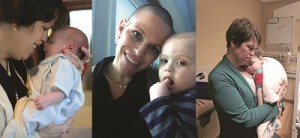All You Need to Know About Appendicitis
 Appendicitis is the most common reason for emergency surgery in children. About 8 percent of Americans suffer appendicitis during their lifetime. While appendicitis can occur in adults, the majority of cases occur in children between the ages of 6 and 16 (about 80,000 kids per year in the United States).
Appendicitis is the most common reason for emergency surgery in children. About 8 percent of Americans suffer appendicitis during their lifetime. While appendicitis can occur in adults, the majority of cases occur in children between the ages of 6 and 16 (about 80,000 kids per year in the United States).
What is the appendix?
It’s a small finger-shaped organ that is attached to the end of the large intestine. It’s not clear why we have this appendage. There is evidence to suggest that early humans needed it to aid in digestion, but today the appendix has no known function. Appendicitis occurs when this organ becomes infected.
Kids have belly pain all the time for a wide variety of reasons: gas, too much ice cream, stress or viruses (“G.I. bugs”). Unlike other causes of abdominal pain in children, pain from appendicitis is unrelenting. It doesn’t come and go. Appendicitis is progressive, evolving from mild, achy pain to more severe over a period of 24-48 hours. Pain is typically the first sign, preceding other possible symptoms, such as nausea, vomiting, loss of appetite and low-grade fever.
Appendicitis pain starts in the middle of the belly and migrates to the right lower abdomen where the appendix resides. Movement worsens the pain. Children with appendicitis tend to hold still. They don’t want to walk, sit up, twist or turn. Classically, they complain about bumps in the road on the car ride to the hospital. When a child with appendicitis is lying down and relaxed, a gentle push on the lower right side of the abdomen always causes pain — called “right lower quadrant tenderness” by the doctors.
OK, now I’m worried about appendicitis. What should I do?
The first step is call your pediatrician’s office. Their team listens to the symptoms you share and can make a decision. Sometimes a quick visit to the pediatrician’s office can rule out appendicitis. If it’s outside of normal business hours or the suspicion for appendicitis is high, you may be directed to an urgent care or emergency department.
Here in Charlotte, we are fortunate to have two excellent pediatric emergency rooms, one at Levine Children’s Hospital (at Atrium Health Carolinas Medical Center) and one at Hemby Children’s Hospital (at Novant Health Presbyterian Medical Center). Each of these facilities is staffed by pediatric emergency physicians and nurses who exclusively care for children. Our recommendation is to have your child evaluated at one of those facilities, rather than an outlying urgent care or suburban emergency department where pediatric expertise may or may not be present. Though it might be a 15-minute further drive, your child will receive the best, most specialized care. And if it turns out your child does, in fact, have appendicitis, a time-consuming and expensive transfer to a children’s hospital is not required.
How is appendicitis diagnosed?
The diagnosis of appendicitis takes into account the story of the child’s illness, the characteristics of the child on physical examination, laboratory values obtained with a blood draw, and the results of radiologic studies, like ultrasound or CT scan. Most children with appendicitis do not require a CT scan for diagnosis.
How is appendicitis treated?
The standard treatment for typical appendicitis is a short, simple operation to remove the appendix before the appendix ruptures, which rarely happens until symptoms have lasted over 72 hours. Although the thought of an operation is scary, it needn’t be thanks to laparoscopy, or minimally invasive surgery. With very small, specialized tools and scopes, pediatric surgeons can remove an infected appendix with a few small incisions. The average procedure time is less than 30 minutes, and most children go home within six to 12 hours of surgery. Yes, often the same day!
After an appendectomy, kids have some achy discomfort from the operation that diminishes over three to five days, and athletic activities are limited for one to two weeks. The risk of any major complication following appendectomy for typical appendicitis is very low (less than 1 percent). Studies have been performed to determine if some children with appendicitis can be safely treated with antibiotics alone and not surgery. Complication rates in children treated without surgery are unacceptably high compared to children treated with surgery, so laparoscopic appendectomy remains the standard treatment for children with typical appendicitis.
In about 20 percent of cases, the appendix is perforated at the time of diagnosis, which means there is a small hole in the wall of the appendix. This is also known as a ruptured or burst appendix. When it occurs, the infection from inside the appendix leaks out into the abdomen. Children experiencing this condition usually have a longer recovery and are best treated with an extended course of antibiotics.
Many children with perforated appendicitis receive surgery at time of diagnosis, but sometimes, if the appendix has been perforated for an extended period of time, the best treatment is initially just antibiotics, followed by interval appendectomy after the infection resolves. Interval appendectomy is usually out-patient surgery performed eight to 12 weeks after the initial diagnosis.
For many parents, appendicitis is their first exposure to pediatric surgery. They may not know what to ask when a surgeon is referred to them. Remember that it is your right to choose the surgeon who operates on your child, and you should feel very confident in your pediatric surgeon’s abilities. To ensure the best outcome, look for a board-certified pediatric surgeon. Then ask as many questions as you need to feel comfortable.
The surgeons of Pediatric Surgical Associates have made important contributions to the improvement of appendicitis management in recent years, publishing data in the surgical literature on multiple subjects, including the minimization of CT scan radiation, more efficient diagnosis, better antibiotic stewardship, and streamlining the recovery and discharge process for children with appendicitis.
This blog was produced in partnership with Charlotte Parent. Click here for the original post and other parenting resources.
Transitioning From Pediatric Care
 By Anna Schmelzer, MD, and Thomas Schmelzer, MD
By Anna Schmelzer, MD, and Thomas Schmelzer, MD
One of the reasons we love pediatrics as a focus is the joy of seeing our patients grow before our eyes. Their waiting room experience is very telling. First, there are the babies that can sit in the car seat while parents read a magazine. Then come the toddler years when drawing them away from the fish or toys to go see the doctor literally is a feat of strength. The school-aged children are sometimes working on homework or reading a book. (Although let’s be real, they are usually utilizing some electronic device to bide their time.) But there is an age when most patients look around the waiting room and think: What am I doing in this room filled with babies?
Pediatric care encompasses physical, developmental health, as well as mental and psychosocial health, and can extend from the time of conception through early adulthood. The decision to transition to an adult provider can be complicated, especially in the presence of a chronic medical condition. The American Academy of Pediatrics has published guidelines outlining the age of 21 as the time to transition, but recognizes exceptions to consider on a case-by-case basis. Following are considerations for deciding when to transition away from a pediatrician to an adult physician.
What to Expect From Your Child’s Pediatrician
Pediatric providers help prepare your child a transition to an adult physician. Pediatricians should begin talking to patients in private sometime in the early teen years. Just like learning to pay bills or pump gas, an adolescent needs to learn to tell their own story and start to practice advocating for himself or herself. The provider can also help guide you, as the parent, if there are any considerations as described below.
The pre-college exam is a nice time to start the discussion of other resources if it has not already been addressed. Whether it is the student health options on campus, or mental health support provided by their school, college students need to know that they have other avenues open to them. We recommend starting the dialogue with your child and pediatrician in late high school to see what fits your specific child’s needs.
Most pediatric primary care and specialty groups have general, but not absolute, age cut-offs. For instance, Charlotte Pediatric Clinic sees its patients through college or until the age of 22. All the surgeons at Pediatric Surgical Associates are double boarded in both pediatric and adult general surgery. PSA sees patients through college or age 22, but this depends on the specific need. On the other end, internal medicine groups may not see patients younger than 18.
Chronic Medical Conditions
When chronic conditions are present from birth or at a very early age, they are managed by pediatricians and pediatric specialists. Examples would be congenital heart disease or cystic fibrosis. Once a child is older, finding an adult specialist can be difficult. For this reason, the pediatric specialist may continue to manage care beyond 18 or 21 years of age. They often, however, can help find a physician to transition your care to when they time is appropriate.
For some other diagnoses, the opposite is true. Chronic conditions that arise during early adulthood may be better managed by an adult specialist and possibly an adult primary care physician sooner than 18 to 21. If this is the case, it may be beneficial to transition care for this newly diagnosed disease to an adult specialist rather than starting care with a pediatric specialist and needing to change doctors in a year or two.
Changing Needs of the Patient and Sexual Health
Situations such as the need for gynecologic resources is a good example of transitioning earlier to streamline care. Individual pediatric groups have different approaches when it comes to contraception or management of sexual health. If patients need care in these areas, especially if they are close to the age the practice generally transitions, that could be a turning point. It may be more useful to transition to an adult primary care physician who can pick up the role of health maintenance, but also address the specific issues that are more likely to arise in the older patients.
Consent for Treatment
Age of consent is another issue to consider. Once 18, a child can legally sign consent for treatment and surgical procedures. For instance, after turning 18, the patient is asked to sign the forms for vaccines or procedures despite still being with a pediatric practice.
Mental Health
As children grow up, they have more adult feelings and needs from a mental health standpoint. Despite a pediatrician being perfectly capable and qualified to address these concerns, your child may not feel comfortable discussing these certain topics with the provider who has seen him or her throughout childhood. If a referral needs to be made to a psychologist or psychiatrist, there may be more availability with the providers who see primarily adults if the patient meets the minimum age requirements.
Insurance Considerations
There are some instances when insurance does not cover visits to a pediatrician or pediatric subspecialist when the patient is over age 21. This is policy-specific and worth a look as your child gets older.
The timing of transitioning from pediatric to adult care varies slightly depending on the needs of the individual patient, as well as the general age set out by the pediatrician. From day one, a pediatrician’s goal is the same as yours: to help set babies up to be the healthiest adults possible, even when they have “outgrown” pediatric care.
Anna Schmelzer, MD, is a board-certified pediatrician at the SouthPark office of Atrium Health Levine Children’s Charlotte Pediatric Clinic, and Thomas Schmelzer, MD, is a board-certified pediatric surgeon at Pediatric Surgical Associates. They are married and have two children.
This blog was produced in partnership with Charlotte Parent. Click here for the original post and other parenting resources.
E-cigarettes and Teenagers: A Growing Epidemic
 Dr. Walid Eltaraboulsi, Tryon Medical Partners
Dr. Walid Eltaraboulsi, Tryon Medical Partners
Though the use of electronic cigarettes (e-cigarettes) among teenagers was essentially non-existent five years ago, it has risen to epidemic proportions. How did we get here? How bad is it for your adolescent or teen? How do you talk to him or her about it? Let’s start with the basics.
What is an e-cigarette?
An e-cigarette is a cigarette-shaped device that heats liquid into an aerosol that the user inhales. In addition to flavoring, the liquid usually contains nicotine, which is highly addictive. E-cigarettes are considered tobacco products because most of them contain nicotine, and nicotine comes from tobacco. Using an e-cigarette is called “vaping.”
In the last few decades, we have seen tremendous progress in our nation’s addiction to tobacco cigarettes. In fact, the percentage of tobacco smokers was at an all-time low last year and that is great news! Unfortunately, e-cigarettes usage rates among middle and high school students in the United States have increased tremendously in the last five years. Commissioner of the FDA, Scott Gottlieb, has called the surge in electronic cigarette usage in the teenage population an epidemic. In 2018, one in five high school students reported using e-cigarettes in the last month.
What are the health risks?
Brain risks: The brain is known to grow and develop until the age of 25. Nicotine can affect the way certain connections form within the brain, which can harm parts of the brain that control attention and learning. Among other concerns of exposing developing brains to nicotine are nicotine addiction, mood disorders and lowering impulse control.
Respiratory health risks: A recent study from Duke University shows asthma-like symptoms from smokers of e-cigarettes. Another concern is a disease related to the diacetyl compound from flavoring in e-cigarettes, known as popcorn lung or bronchiolitis obliterans. Scientists are still studying the health effects of the various other compounds found in e-cigarettes.
Use of other tobacco products: E-cigarettes among youth and young adults are linked to the use of other tobacco products such as cigarettes, cigars and hookahs. Some people have suggested that the use of e-cigarettes among teens may protect them from smoking tobacco cigarettes. There is no evidence for this claim. Nearly three out of five high school smokers also use e-cigarettes.
What can you do to protect your child?
The surgeon general has a great website dedicated to opening up the conversation between adults and their children about e-cigarettes. These are the tips I find most helpful for parents:
- Find the right moment. A more natural discussion will increase the likelihood that your teen will listen, rather than saying “we need to talk.”
- Be patient and ready to listen. Avoid criticism and encourage an open dialogue. Don’t lecture.
- Set a positive example by being tobacco-free. If you use tobacco, it’s never too late to quit. If you have trouble quitting, talk to your doctor and ask for help.
Despite the increasing usage of e-cigarettes among young adults and accompanying health risks, there are some encouraging signs that we, as a society, will not let e-cigarette use cause the same kind of damage as tobacco cigarettes. The FDA and surgeon general have recognized the problem early and released position statements. We have non-profit organizations developing anti-vaping commercials targeted to young adults.
And you are not alone! As a parent, you have access to many resources to start a conversation with your child and keep it open and on-going, helping your family be smoke-free.
Dr. Walid Eltaraboulsi is a board-certified pulmonologist at the Ballantyne location of Tryon Medical Partners, and is an expert in e-cigarette use among adolescents and teens. He holds a board certification in Critical Care Medicine. He has a Masters of Public Health and is getting his Masters of Business Administration.
This blog was produced in partnership with Charlotte Parent. Click here for the original post and other parenting resources.
So Your Child Needs Play Therapy. What’s Next?
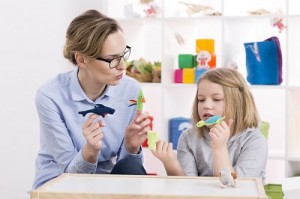 By Emily Cannon, MSW, LCSW, RPT
By Emily Cannon, MSW, LCSW, RPT
Through play therapy, children learn to express their feelings, modify their behavior, develop problem-solving skills and learn a variety of ways to relate to others. In part one of this blog, we covered what play therapy is, what types of challenges it can help your child overcome and how it works. Part two of this blog post helps to demystify the overall process for those who have decided play therapy might be worth trying.
Family Involvement
Though play therapy is intended for your child, the whole family should be involved and supportive. Prior to meeting with a child, a play therapist sits down with parents to gain family and developmental history. This “intake” helps the play therapist understand the presenting issue, learn more about family dynamics and formulate a plan for treatment.
If you have not experienced therapy or counseling before, this world might be foreign to you. You may have reservations about your child being in therapy, or doubts about its effectiveness. Talk to your child’s therapist about how you are feeling so you can be prepared to be 100 percent supportive.
Positive Approach
When it comes time to introduce your child to the idea of play therapy, take a positive approach and keep it simple. Never frame therapy as though it is a punishment for your child’s behavior, and never use going to therapy as a threat to illicit improved behavior.
Demystify mental health by correlating it with traditional health care. You can say something like, “You know how we go see Dr. Smith when your throat hurts or your tummy is really upset? Well, I met a nice lady and she is kind of like Dr. Smith. She is like a doctor but for feelings.” For younger children, a simple, “I thought it would be nice for you to have a grown-up friend who can have special play time with just you.” For a child, realizing that they can have an adult’s full, undivided attention is very powerful.
Generate Excitement to Lessen Anxiety
Most play therapists have pictures of their playrooms on their website. Sometimes showing a child those images prior to a session can help lessen anxiety. When I meet with parents for an intake they usually comment on something in the playroom they know their child will be drawn to or something they also have at home. I encourage them to let their child know about those toys; sometimes it even creates excitement.
Once your child starts seeing the therapist, the first phase of play therapy is aimed at developing a safe and trusting relationship between the child and therapist. Play can be very surface level during this time. Once children have built therapeutic rapport with their therapist, themes generally develop in play revealing what is going on in a child’s inner world.
While most kids look forward to coming to their play sessions, it is emotional work and change is being created. There can be some push back. Just like many things in life, you can’t go around it, you have to go through it. I always warn parents that they may see an increase in some of the behaviors that brought them into therapy for a period of time, but it is part of the child’s way of working through it.
In addition to the clinical work with the child, a play therapist also works very closely with parents throughout the process to help them gain insight into their child’s behavior and add tools to their toolbox to best support their child when he or she is at home or school.
Graduation!
The last phase of play therapy is graduation. This occurs when the parents, child and therapist feel confident that the gains made through the play therapy process are maintainable without regular sessions. It is common for children to sometimes come in for “check-up” sessions to review certain skills, or on an as-needed basis if other issues arise.
Emily Cannon is a licensed clinical social worker and has been working with children and families since 2007. Emily opened Pathways to Growth Counseling in 2012, with the goal of providing comprehensive services to individuals and families in and around Charlotte.
This blog was produced in partnership with Charlotte Parent. Click here for the original post and other parenting resources.
Play Therapy: Is It Right for Your Child?
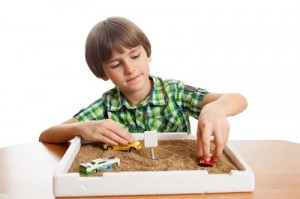 By Emily Cannon, MSW, LCSW, RPT
By Emily Cannon, MSW, LCSW, RPT
Clinically-speaking, play therapy is the most developmentally-appropriate treatment model for preschool and elementary age children; simply put, play therapy helps children express their feelings by “doing” rather than by directly talking about and reflecting upon what’s bothering them.
Typically, children do not have the insight or vocabulary to directly verbalize their feelings or experiences like adults do. Children express themselves through behavior, which, observed by a professional play therapist, can provide immeasurable insight into how they process life experiences like divorce, illness, death of a friend or family member, abuse or bullying. (It’s important to note, stressors can also include positive changes like going to a new school, getting a new sibling or being adopted into a loving forever family!)
Play provides children with psychological distance from their problems. The playroom is a safe space where a child can play out life experiences by breaking them down into smaller parts. They learn to communicate how they are feeling about each part, work through it and release the associated emotions. They develop problem-solving skills that can apply to various settings in their life.
Here’s how it looks:
In an initial session with a child, the therapist will usually engage the child in playing a game they may be familiar with in order to build rapport. For example, I will frequently use the game Jenga and have questions written on the bricks ranging from things like, “What was your best birthday ever?” to “If you could wake up tomorrow and something could be different, what would you change?” In future sessions, sometimes the child will naturally gravitate toward certain things in the room and I will follow the lead they take in their play. Other times, I might provide a prompt, such as asking them to draw or create something specific, do a puppet show or create something in our sandtray about their friends or something at home, etc.
They are then able to project themselves and other “key players” onto animals, puppets or doll house figurines. As we process what has been created, we can then discuss what the lion may be feeling, or how to help the sheep puppet join in with the other farm friends. It usually clear to the therapist who the child is in the world he or she has created. It is safer and more comfortable for the therapist to explore things about the character the child has projected themselves onto instead of making it directly about them. Often I will say things like, “I wonder if you ever feel out of control like the lion does?” etc. as part of the processing and skill building.
Play therapy provides a good foundation for all kids. Play therapy promotes self-regulation, an internal sense of esteem and healthy coping skills to assist in whatever may arise down the road. Any child can benefit from it regardless of having a specific stressor or struggling with something like anxiety, depression or ADHD.
If you think your child could benefit from play therapy, the first step is to find a play therapist you like that you think will best connect with your child. Look to work with an individual who is a Registered Play Therapist (RPT) or someone in the process of becoming an RPT, meaning they are under the supervision of someone who is already an RPT. A great resource for finding an RPT in your area and more information on play therapy is the Association for Play Therapy. School guidance counselors and pediatrician offices can also be a great source for referrals.
In two weeks, I will share Part Two of this blog, about how to prepare yourself and your child for play therapy. Until then, stay well.
Emily Cannon is a licensed clinical social worker and has been working with children and families since 2007. Emily opened Pathways to Growth Counseling in 2012, with the goal of providing comprehensive services to individuals and families in and around Charlotte. This blog was produced in partnership with Charlotte Parent. Click here for the original post and other parenting resources.
When Your Pediatrician Changes Practices
 As a pediatric surgeon, it is common to be asked for medical advice. Recently, however, another question has become much more common: “My pediatrician has changed practices. Should I stay or go?”
As a pediatric surgeon, it is common to be asked for medical advice. Recently, however, another question has become much more common: “My pediatrician has changed practices. Should I stay or go?”
There is a lot of news these days about physicians changing from Atrium to Novant, Novant to Atrium or from either system to an independent practice, and vice versa. Although these changes can be confusing, remember that ultimately this is a good thing. In Charlotte, we are lucky to have two excellent hospital systems and many independent practices that provide options for doctors to practice. This choice often works to patient advantage as well if you want to change, or if you need to change because you moved or switched insurance carriers.
To answer the original question, if you really love your doctor then stick with him or her. You DO NOT have stay with the health system or practice with which your doctor was formally affiliated, even if that system or practice implies that you do. However, understand that changing practices to follow your doctor can present challenges you might not have thought of, especially if you’ve been with your doctor for a while.
If you do decide to follow your doctor and change practices, keep the following in mind:
- Be sure your doctor remains in-network with your insurance plan, especially if you’re from out of state, as some plans have a very narrow pool of providers. In order to verify in-network status, call the new practice and give them the exact name of the provider and type of policy.
- Your child will be a new patient to the practice regardless of how well your doctor knows him or her. You will need to fill out all the requisite paperwork and register on the practice’s preferred patient portal. If the new office does not have access to the old practice’s medical records, you will have to provide a release so they can obtain that information.
- The office and nursing staff do not always follow the doctor, and these people can be very important to your family’s care! At Pediatric Surgical Associates, we put great emphasis on prompt and expert service provided by our staff. Often they are the primary contacts with patients. Make sure you are comfortable with the office staff of your doctor’s new practice; bad service might be a deal-breaker. If you do receive inadequate service, make sure your doctor is aware.
Whether you decide to stay with your doctor, or with his or her old practice instead, remember that it is YOUR RIGHT AS A PARENT to make that decision. Many parents have come up to me and said they’ve felt pressure to stay with a practice when their pediatrician has left. Unfortunately, it is standard practice to not even tell parents where the old pediatrician has gone. Be persistent if you want to stick with your same doctor. On the other hand, if you feel most comfortable staying with a particular practice and its staff regardless of where your doctor goes, then that decision should be respected as well.
When it comes time to choosing the right pediatrician, my advice is to ask questions, take notes and get a second opinion if you need one. Read more tips in this blog post I wrote a few years ago.
Remember that your child gets your best every day, and your child deserves the best of your physician and your practice, too.
This blog was produced in partnership with Charlotte Parent. Click here for the original post and other parenting resources.
Constipation: Answering the ‘Hard’ Questions
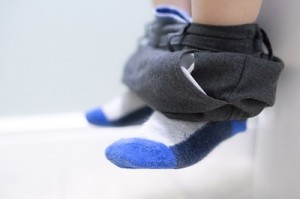 By Dr. Jason Dranove, Pediatric Gastroenterologist
By Dr. Jason Dranove, Pediatric Gastroenterologist
Of all the adjectives used to describe constipation, “frustrating” is by far the most commonly used by parents in my practice. If you are reading this article, know that you are not alone. Constipation is a very common complaint of otherwise healthy children. Understanding the answers to the following commonly asked questions will give you a solid foundation in the subject, so let’s get moving.
Q: What is a normal bowel pattern?
A: This will vary based upon age. “Normal” stools are not rock hard, and not watery, but anywhere in between. Breastfed infants can stool anywhere from once a week to as much as with every diaper change. For formula fed and older infants, stooling between three times a day and three times a week can generally be considered normal.
Q: What is constipation?
A: There are technical definitions of constipation, however the answer really is “you know it when you see it.” In practical terms, constipation is difficulty passing stool. Even if your child stools daily, if the stool is hard, dry, and associated with straining and pain, that is constipation. If your child stools only three times a week but they are soft and painless, that is normal.
Q: What causes constipation?
A: In a nutshell, the muscles of the colon (large intestine) contract and move stool from the beginning (ascending colon) through to the rectum. This is mostly controlled by nervous system input to the colon, which is out of our control. Staying well hydrated and eating a balanced diet can help with colon movement. Some kids, however, have naturally slower colon movement than others, which may lead to constipation.
The most common cause of constipation is “stool withholding,” when instead of relaxing our bottom while attempting to stool, we contract our pelvic muscles and external anal sphincter to prevent stool from coming out. Repeating this over time will cause the rectum to distend, which only worsens the problem. Fear of defecation due to a history of painful bowel movements or due to inconvenient timing (not wanting to stop playing) are common causes of this behavior.
Q: What are “red flags” that constipation is from a serious underlying medical condition?
A: Well over 95 percent of constipation is called “functional” constipation, meaning there is no medical or surgical cause. However, red flags that should prompt medical attention would be lack of meconium bowel movement at birth, failure to thrive, abdominal distension and blood mixed in stool, among others.
Q: How can I help my constipated child?
A: Provide a healthy, balanced diet, a supportive and positive environment during toilet training, and look for the stool withholding behavior discussed above. If your child is still exhibiting signs of constipation despite the above, or if they develop fecal incontinence (accidents) after already being toilet trained, please bring this up with your child’s doctor.
Q: What are the most commonly prescribed medical treatments for constipation?
A: There are medications called “osmotic laxatives,” which hold water in the colon to soften stool and make it easier to pass (Lactulose for younger infants, Miralax for older infants and children). There are “stimulant laxatives” which help the colon to contract, usually used on an intermittent basis when osmotic laxatives are not working (Senna or Bisacodyl). There are suppositories and enemas given at certain times, but in general we try to avoid using these.
Q: Will my child become dependent upon laxatives?
A: The medicines themselves are not habit forming and have no chemical dependency. Your colon does not “forget how to work.”
Q: Will this ever get better?
A: The vast majority of children will improve and go on to have a normal bowel pattern. A small percentage of children do develop chronic or severe constipation, which is where a pediatric gastroenterologist can be of help.
Dr. Dranove is board certified in general pediatrics and pediatric gastroenterology, hepatology and nutrition. He is a fellow of the American Academy of Pediatrics and the director of neurogastroenterology and motility disorders in the division of pediatric gastroenterology at Atrium Health Levine Children’s Hospital.
This blog was produced in partnership with Charlotte Parent. Click here for the original post and other parenting resources.
Lessons Learned After Losing a Child to Cancer
Meg McElwain lost her son Mitchell to leukemia when he was only 2 years old. Since his death in 2014, Meg and her son Frank Turner IV, have been open about their grief journey.
Meg is a philanthropist at Mitchell’s Fund, the non-profit she founded to help families struggling to cover the living expenses during the crisis of a life threatening pediatric illness. The heart of Mitchell’s Fund is pediatric cancer, but the fund also supports pediatric behavioral health. She believes her purpose is to help others recover after loss. This is what she learned and would like to share from the experience of losing a child.
Things Happen Fast
When Mitchell first got sick, things happened really quickly. He was only 3 months old when we noticed bruising on his legs. That was a Sunday on the afternoon of his baptism. We went to the doctor the next morning who immediately recognized something was very wrong with Mitchell. He ordered a blood panel, and by noon Monday, we knew Mitchell had white blood cell cancer. By 5:30 p.m. that evening, Mitchell was diagnosed with a rare form of leukemia with a 40 percent chance of survival and chemotherapy to start the next day. There was no time to sit and think.
I am so thankful we were taken seriously and not told to “watch and wait.” Getting a blood panel immediately gave us the diagnosis we needed to start aggressively treating the cancer. That is likely why we had as much time with Mitchell as we did.
Listen to Your Nurses, not Dr. Google
Our doctors gave us material to read and told us NOT to Google anything about leukemia. We listened and I am glad we did. Dr. Google will tell you your foot’s going to fall off when you have a hang nail. We trusted our medical team and were open to the social services the children’s hospital offered. That gave us an incredible amount of hope.
Acquaintances Forget. Friends Don’t.
In the beginning, everyone was there to help whether it was cooking meals or helping with Frank, who was 3 at the time. But that stopped, especially after Mitchell died. People went back to their lives and were less attentive about our circumstances, which is human nature, but can also be hurtful.
In a way, I think people feel like they are supposed to get back to normal, but there is no normal after you lose a child. Everything changes. It has become impossible for me to hear a baby cry without thinking about the child I once rocked to sleep. It’s hard seeing other children achieve milestones that my child never will. Mitchell would be starting first grade this year.
Through this experience, I learned a lot about the people in my life. Some people are drawn to tragedy in a strange way or are grief vultures. The people whose friendship I value the most made it a point to circle the anniversary of Mitchell’s death on their calendar and reach out to say, “I know it’s coming up and I am sorry. I am praying for you and I love you.”
People say Stupid Things
After I lost Mitchell, people said the most ridiculous things, like, “you need to have another baby,” or “you need to adopt a child.” It was also unhelpful to hear, “he’s in a better place,” and “you’re so strong.” Once someone said, “if you stop talking about it, maybe it will get better.” I get it … it’s hard to know what to say, but I always value when someone just lets me talk about him and how much I miss him. Sometimes just saying, “I love you,” is enough.
It’s OK to say What you Need and What you Don’t
The experience of losing my son has made me less inclined to engage in drama and to be more direct. For example, some people are big huggers — I am not one of them. Eventually, I told people hugs were not what I needed. After Mitchell died, there were certain conversations I just had to remove myself from though people may have not understood why. I turned down offers of help that weren’t helpful as well-intended as they were. I think some people wanted to “fix” or “help” me. If you are grieving the loss of a child, it’s not about other people, it’s about you. I think this is why many marriages end in divorce after the death of a child. Each person grieves differently and the pain often causes such differences that relationships suffer. My marriage to Mitchell’s dad ended in divorce three years after Mitchie died.
There’s Always More Beyond the Surface
Whether it’s a marriage in trouble, impending financial ruin, addiction or mental health illness, there’s always more going than just the long-term critical illness. Mitchell’s illness went on for two years, and there were so many other things we were dealing with that others never knew about. Much of the stress families feel during this time is financial because one parent has to basically live at the hospital while the other works or cares for other children.
Childhood cancer treatment protocols are so much more intense and fast paced that adult cancer. There is more time in the hospital and at the clinic. This is one of the big reasons why I started Mitchell’s Fund, to try to alleviate the burden of everything else that happens at the cost of prioritizing your critically ill child.
Life Goes on
You are never not going to feel the pain, but it gets easier to carry. The first two years were the absolute worst. … I felt so emotionally heavy and physically burdened. But after I had been through the second Christmas, the second Easter, the second Mother’s Day, I knew I could get through it because I had done it once before. It was then that I felt I could really move forward. I miss him every single day.
You will Survive
I now know my purpose on this earth: to channel my hurt to help others heal. Whether fund raising for Mitchell’s Fund, speaking to groups about resilience or just being more present with my living son, I am more intentional with everything in my life and have learned that living slower is better. At the end of it all, I will hold by baby again and hear him say “Mama.” I can’t wait.
Meg McElwain is a professional speaker and blogger on resilience. Learn more about her at megmcelwain.com.
This blog was produced in partnership with Charlotte Parent. Click here for the original post and other parenting resources.
Help, My Child is Sick on Vacation!
 By Anna Schmelzer, MD, and Thomas Schmelzer, MD
By Anna Schmelzer, MD, and Thomas Schmelzer, MD
Two years ago, six children on our beach vacation developed symptoms of hand, foot and mouth disease. As physicians, we appreciated watching the various symptomatology and timeline of transmission in our small sample size (insert pushing our nerdy glasses up our noses here). As their parents, however, it added a facet of stress to the week that we could have done without. Much anticipated vacations can be derailed by illness or injury, making it memorable for other reasons. In anticipation of the upcoming summer season, we have compiled some practical advice based on common questions asked in our practices.
A little research prior to leaving is worth it. During the planning stages, consider where you will be traveling and what resources are available. Is there a hospital? Is it a children’s hospital? Are there any urgent care clinics close by? We are very fortunate in Charlotte to have urgent care clinics that only see children but this is not the case in many areas. Ask relatives you may be visiting if there are local pediatricians who could see your children, should an illness arise.
When packing, make sure to include not only daily medications, but also as-needed prescriptions, such as epinephrine pens and asthma rescue inhalers. It is a good idea to pack over-the-counter fever medications, hydrocortisone and Benadryl along with your sunscreen and bug spray. Additionally, write down a list of everyone’s known drug allergies, daily medication dosages and dates of last tetanus vaccines. A quick memo on your phone could save you a panicked call to your home pediatric office.
Try not to overload yourselves with equipment you may not need but do think ahead with regards to safety measures, including car seats. Airlines may have specific requirements regarding air travel with children and proper restraints. Two helpful resources include the American Academy of Pediatrics and the Centers for Disease Control and Prevention for travel tips with children.
Some of the most common problems encountered on vacation include gastroenteritis, food poisoning, fevers, sunburns and minor injuries. Initial treatments for signs of vomiting or diarrhea include home therapies like Pedialyte and rehydration. If your child is worsening, however, or not improving over 24-48 hours, it would be time to take other steps. For sunburns, prevention is key. Do not overlook good sun protection just because your trip does not involve the beach.
Minor injuries and cuts should be able to be managed at an urgent care, if available. Less commonly, broken bones or surgical issues arise. Consider how remote your location is when deciding when to seek medical care. For instance, if you are far from any medical facility and something happens, seek care earlier rather than later just to be safe. Emergent surgical issues that arise would be triaged by local physicians and transfers would be made based on the comfort level of that institution to take care of children.
If you are uncomfortable or have questions, consider calling your home pediatric office. Triage nurses at Charlotte Pediatric Clinic commonly answer questions for our traveling families and can assist in starting home therapies over the phone. The surgeons at Pediatric Surgical Associates often know the providers in their specialty in other parts of the country and can act as a resource if contacted.
Canceling a trip or going home due to illness should be considered when a problem arises that will need close follow up or the illness/injury substantially interferes with the activities you have planned. As in our case last year, our son’s broken arm sustained three days prior to a trip that involved water activities called for a readjustment. In general, if local resources are sparse, think carefully about participating in high risk activities like zip-lining, parasailing and scuba diving.
Last but not least, age appropriate flexibility is key. Try not to overschedule everyone before you get there. Concentrate on the time away from day-to-day activities and remember the “family” part of the vacation. Even in the event that a medical situation arises, it will be woven into the memories of your time together, which will help shape your child’s life. Our previous beach vacation may have involved more indoor games and less beach time but we still had fun, blisters and all.
Anna Schmelzer, MD, is a pediatrician at the SouthPark office of Charlotte Pediatric Clinic, and Thomas Schmelzer, MD, is a board-certified pediatric surgeon at Pediatric Surgical Associates. They are married and have two children.
This blog was produced in partnership with Charlotte Parent. Click here for the original post and other parenting resources.
My Child Swallowed a … !
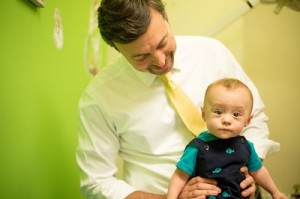 Many of us have experienced the temporary panic of watching our child struggle after swallowing something that “didn’t go down the right way.” Whether the result of consuming a drink too quickly or breathing in while eating a snack, your child starts coughing and sputtering as their watery eyes look at you for help. Most of the time, it’s just an episode of a few seconds. …The drink goes down or the food comes up, and then he or she is fine.
Many of us have experienced the temporary panic of watching our child struggle after swallowing something that “didn’t go down the right way.” Whether the result of consuming a drink too quickly or breathing in while eating a snack, your child starts coughing and sputtering as their watery eyes look at you for help. Most of the time, it’s just an episode of a few seconds. …The drink goes down or the food comes up, and then he or she is fine.
But every once in while something gets stuck! That’s when Pediatric Surgical Associates gets a call.
The medical term for this common problem is “foreign body ingestion” or “foreign body aspiration.” Foreign body ingestion means something went down the esophagus (the tube that connects the mouth to the stomach), and aspiration means something went down the trachea (airway or breathing tube). In either case the “something” can get stuck and must be removed.
Let’s talk about ingestion
Seventy thousand pediatric foreign body ingestions occur each year. Most foreign body ingestions occur in toddlers and preschool-aged children, who inquisitively explore the world around them, often with their mouths. An intriguing object is discovered, mouthed and inadvertently swallowed. Children most commonly swallow coins (which comprise 80 percent of foreign bodies lodged in the esophagus), but other objects we regularly remove include magnets, batteries, small toys, buttons and jewelry.
Although caregivers sometimes see the child swallow the object, as many as half of these cases are not witnessed. These children might suddenly start drooling or throwing up continually, refuse to eat or complain of achy pain in the chest. Many will have respiratory symptoms like coughing or wheezing. They also might not; some children initially show no symptoms whatsoever!
What happens if your child swallows something and seems fine? It is likely that the foreign body has traversed the esophagus and made it to the stomach. Foreign bodies in the stomach and intestine can almost always be left alone, because the child will usually pass it without complication. There are exceptions to that rule. If your child swallows a button-style battery, it is possible he or she will develop an internal burn since the current of those batteries runs continuously. If your child were to swallow multiple magnets, it is possible the magnets could connect and pinch whatever tissue is in the way.
If you are concerned your child may have swallowed a foreign body but seems fine, don’t panic; just call the doctor to be safe. If your child has any of the symptoms described above after a witnessed foreign body ingestion, take them to one of the two pediatric emergency departments here in Charlotte for evaluation.
Now for aspiration
Most foreign body aspirations occur in children younger than 4. Though very often the item is a piece of food (think peanuts and popcorn), we see many interesting non-food items (air-soft pellets, jewelry, beads). Older kids and adults suffering from foreign body aspiration inhale thumbtacks, pen tops, guitar picks, screws and nails — things they were holding in their mouths while their hands were otherwise occupied.
When a child “aspirates” or inhales something, he or she will likely choke on it temporarily, then cough and wheeze. This almost always happens by accident while the child is talking, moving, coughing, singing or sighing. Sometimes the child will have immediate symptoms like noisy breathing. Foods such as nuts or rice may cause trouble several days later after the they absorb enough fluid and increase in size.
Pediatric surgeons remove foreign bodies of the esophagus and airway using a scope under sedation in the operating room. This is typically a brief (less than 10-minute) out-patient procedure (most children go home immediately afterward). In all cases of suspected foreign body ingestion or aspiration, the most important thing you can do is try not to panic and document or retrace what happened before, during and after your child swallowed or inhaled the object. Ask yourself these questions and write down as much as you know or can find out:
- Was your child alone or accompanied when it happened?
- What did your child consume? If you are not sure, look around for what might be missing or out of place.
- What happened immediately after? Did your child turn blue for a short time? How long did the cough persist? Did your child vomit? Did his or her voice change?
Foreign body ingestion and aspiration sound scary, and in some cases these conditions can be serious. But most of the time, we can identify foreign bodies on an x-ray and use minimally invasive methods to remove them quickly and easily. Always err on the side of caution and call the doctor if you have any concerns about an ingested or aspirated foreign body. And if you do need surgery, we’re here.
Dr. Graham Cosper’s research on foreign object ingestion and aspiration was published in “Current Treatment Options in Pediatrics” (Graham H. Cosper & Angela M. Kao, Springer, April 2017). Learn more about Dr. Cosper.
This blog was produced in partnership with Charlotte Parent. Click here for the original post and other parenting resources.




